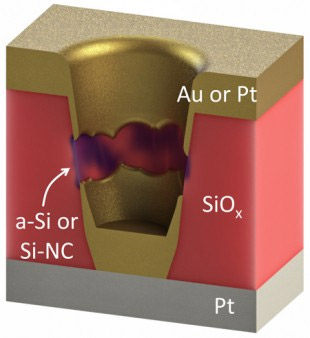 Storage capacities on our smartphones have been increasing quickly. It’s not unusual anymore to see flagship smartphones packing 3GB of RAM but a research breakthrough in memory technology promises to take that to a whole new level in the not too distant future. A research team at Rice University have found a way to manufacture resistive random access memory (RRAM) in a cost-efficient manner.
Storage capacities on our smartphones have been increasing quickly. It’s not unusual anymore to see flagship smartphones packing 3GB of RAM but a research breakthrough in memory technology promises to take that to a whole new level in the not too distant future. A research team at Rice University have found a way to manufacture resistive random access memory (RRAM) in a cost-efficient manner.
RRAM is a new type of memory that operates like flash memory without a constant supply of power. It stores fits of information using resistance technology. Not only does it operate at speeds up to a hundred times faster than flash but more information can be packed into the same ara and it is relatively easy to stack RRAM layers into a single chip. Prototypes the size of a postage stamp that can store 1TB of data already exist.
RRAM itself is not new but it has been difficult and expensive to produce in the past as it needs high-temperatures or voltages. Rice University researchers led by materials science professor James Tour have developed a process by which it can be manufactured at room temperature and with far lower voltages.
“Our technology is the only one that satisfies every market requirement, both from a production and a performance standpoint, for nonvolatile memory,” Tour said. “It can be manufactured at room temperature, has an extremely low forming voltage, high on-off ratio, low power consumption, nine-bit capacity per cell, exceptional switching speeds and excellent cycling endurance.”
The new manufacturing process starts with a layer of silicon dioxide in which tiny (5 nanometer) holes are drilled. The now porous layer is then sandwiched between two very thin layers of metal which act as electrodes. When voltage is applied, the metal fills the holes, forming an electrical connection between the electrodes.. A second voltage is applied to then break the new metal bridge, allowing silicon to fill the new holes. A low-voltage pulse can then be applied to the silicon to change its conductivity and allow it store bits of data.
The first RRAM products, designed for embedded chips found in cars and home appliances such as coffee makers, could be out by the end of the year. A licensing deal is also in the works with an unnamed memory manufacturer suggesting that other commercial applications may not be much further behind.
Who’s ready for a smartphone or tablet packing 1TB of storage?
Sources : Rice University // Engadget
